| itinerary < 8 June onboard the Great Bear II 10 June > | onboard the Great Bear II 9 June 2023 |
 |
Breakfast made up for any inconvenience (we had none. We have been arising about 7am when the generator starts up after, so far, after five good night’s sleep.) We are beset by Murrelets, easily a dozen in a cluster, occasionally uttering their surprising loud cry for such a small bird. The accompanying Gulls mutter and squabble, but the Murrelets appear to be peacefully busy. |
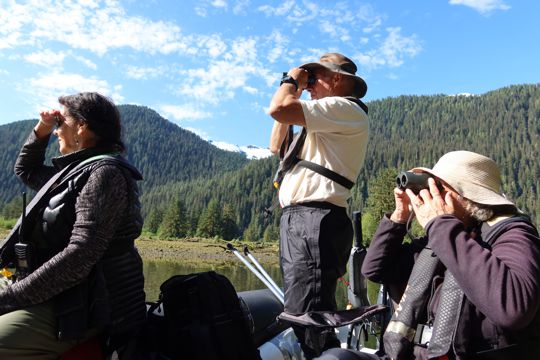 |
This place is apparently thought by the First Nations that care for it, and share stewardship with BC Parks, to be the place where the energy of the two underlying plates, the Pacific and the North American, are in perfect balance, creating a peacefulness that surpasses any other place. It is surely serene and gorgeous; having it populated by Grizzlies, Harbor Seals, Phoebes, Crows, Robins, Harlequin Ducks, the occasional Humpback or Orca, and unnumbered additional species, makes being here a surpassingly wonderful gift.
from left: Marjan, Captain Eric, Rochelle |
|
A note about the pace – partly that specified by the Keepers in honor of the Grizzlies and in furtherance of their effort to preserve the quality bear habitat, and partly due to Captain Eric’s sensitive response to the rhythms and ways of the local Nature – impressed me on the first full day out, the crawl along the intertidal in Jackson Narrows, but only began to feel wholly comfortable this morning, after I had understood the need to keep my eldering body straight and unstressed. Only after sitting silently and quietly for several minutes does the nearby Nature resume operations and allow itself to be observed.
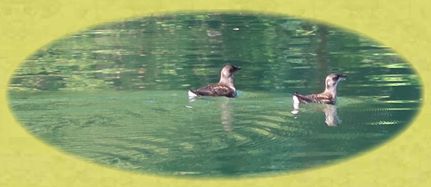 more Marbled Murrelets |
 |
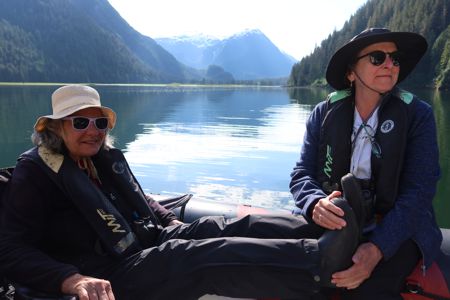 |
Coming back from the head of the estuary, we were too late to clear the gravel beds at the interface between the river and the inlet, and had to disembark and make our way through boot-top deep water (I got some water in my boots) over mossy stones to the dry gravel bar while Eric dragged the Zodiac to deeper water. Our group earned praise for being quick to follow his directions – I can easily imagine some guests would find stepping into water that deep daunting. We also got an eleven from Cap’n Eric when Rochelle asked him to rate our general performance on excursions, particularly our promptness and readiness. Eric recounted some groups’ discomfort out here in far-away Nature: ‘You wouldn’t believe . . .’
'Queen' Annabelle and Sandra |
|
Returning to the Great Bear II I was again struck by the monumental scale of this place, from salty sea level straight up to two miles high. Look closely there in the lower left corner: there's Great Bear II.

The shrimping team convened on the Zodiac to run down the fjord and harvest our bumper crop of shrimp; no joy, except for a small batch of Langoustine in the first trap.
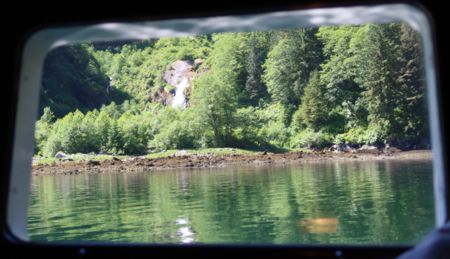 Changing out of my excursion clothes in our bedroom, I happened to catch a view of our neighborhood waterfall out our porthole. This is, for me, one of the perhaps as many as five most perfect places in the world.
|
 |
 |
In my view, trophy hunter should be subjected to torture and grisly death. In a number of inlets here in First Nations territory, crab trapping is forbidden ‘in order to protect . . .’
I want to emphasize again that we are guests here, on land belonging to First Nations people, who rightly consider themselves an integral part of Nature, and treat it with great respect. Only when the white Euro trash showed up did these lands begin to be abused. Guns made it much worse. More about this here. |
|
On our afternoon exploration, with a good high tide, we were able to work our way well back into the estuary. Here, the Spruce trees are heavily weighted with moss. In the estuary, they are subject to the tidal and seasonal erosion, and the channels frequently are decorated with fallen trees in various stages of reclamation. Along the steep rocky shores, the failure mode is that trees grow so heavy in this favorable climate that they exceed the holding capacity of the rocks and thin hydroponic ‘soil’, and, with the help of stormy weather, fall – often taking neighboring trees below them and leaving behind a raw scar on the landscape. Over time, successions of pioneer species rebuild the overburden, and the climax conifers get started again. |
 |
 |
Here’s a ‘Rub Tree,’ a sort of ursine registry where bears scratch their backs, claw the tree, and leave their marking scents and, of course, bits of their fur. The path on the way to these rub trees is often also marked, Eric tells us, by bears ‘walking funny’ as they press and twist their paws in footprints of previous visiting bears, possibly in the same spot for generations. Mouseover for a closeup; on the detail, note the Grizzly claw marks in the upper right corner, and the sap running from their scratching.
 Dinner was pork tenderloin with smoked chantrelle dressing, grilled red peppers, and creamed cauliflower; dessert: coffee cheesecake and mocha ice cream with chocolate sauce . . . and a chocolate covered coffee bean. Rochelle and I were wired ‘til midnight!
Let the following picture forever establish that Trina is a first-rate kayaker: |
 |
|
After dinner, conditions were perfect for alpine glow on the surrounding mountaintops. |
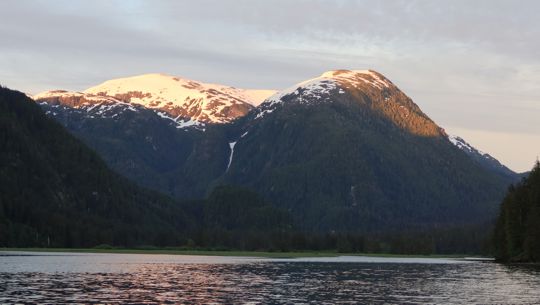 |
 |
updated 16 June 2023 Caspar Time site software and photographs by the Caspar Institute except as noted this site generated with 100% recycled electrons! send website feedback to the CI webster © copyright 2002-2024 Caspar Institute |